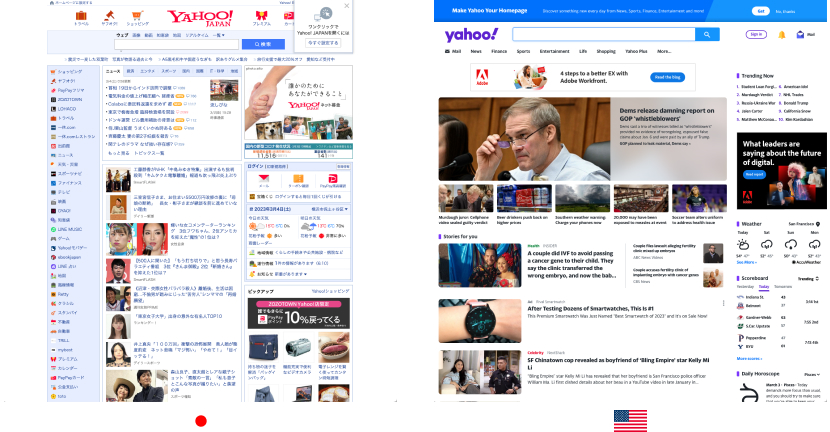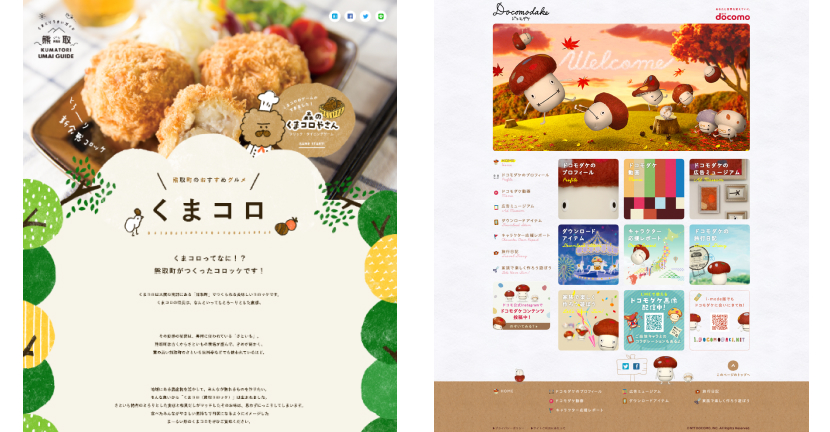
Btrax Design Company > Freshtrax > Japanese Web De...
Japanese Web Design Traits & Localization
We at btrax often provide support for design and marketing localization. However, you might be wondering: why is design localization necessary in the first place? In this article, we’ll explore a few of the reasons why localization is important and necessary.
This time, we will focus specifically on web design and explain the characteristics or features that are unique to Japanese web design to unravel the reasons why localization is needed to succeed.
Feature 1: Maximalism

(Reference: Movie “La La Land”)
The poster of the movie “La La Land” is often used as an example to showcase how different countries use different design styles. As you can see here, the Japanese version contains much more information compared to the U.S. version. This tendency of maximalist style in Japanese design can be seen frequently, including web design. Starbucks, Yahoo!, and other Japanese websites often exhibit this style.

(Left: スターバックスコーヒージャパン Right: Starbucks Coffee)
One of the possible reasons behind this is the richness of Japanese textual culture and the high level of reading comprehension associated with it. Japan has a rich textual culture, and it’s common for a lot of information to be packed into a single page, as seen in flyers, comics, newspapers, magazines, and more. This inherent analog design maximalism seems to be reflected in digital designs like websites and is preferred by Japanese consumers.

(UNIQLO‘s Flyer)
Over time, through exposure to maximalist analog design, Japanese people may have inadvertently trained themselves to accurately process and not overlook important information.
Additionally, Japanese users tend to feel more reassured when there is more information available. For Japanese people, the more detailed the information, the more trustworthy it seems. Therefore, Japanese design primarily focuses on “conveying information” as its main objective, with “presentation/look” being secondary.
As a result, the emphasis is placed on ensuring that “all information is conveyed if read,” and maximalist methods are often employed.
In contrast, American design is created with the mindset of “less is more”. This preference for minimal design can be observed in countries outside the United States as well. In fact, according to research conducted by Goodfirms, about 85% of respondents (web designers based in the USA, Ukraine, and India) claim that a common mistake/failure in web design is a “cluttered design with too much information.” (Reference: Goodfirms)

(Left: Yahoo! JAPAN Right: US Yahoo!)
However, design preferences and trends change over time. Recently, there has been an increase in designs that emphasize minimalism and visual elements, hence it’s not accurate to categorize all Japanese designs as maximalist.
Feature 2: Characters and 2D Illustrations
In Japanese web design, cute characters and 2D illustrations are frequently used. These elements play a role in creating a friendly and welcoming atmosphere and enhancing a brand’s uniqueness.
Japan has a strong pop culture rooted in anime and manga. By incorporating this culture into websites, it is believed to evoke user empathy and make users feel more familiar with the brand.
Characters and illustrations are also effective at conveying emotions. Through the expressions and poses of characters, emotions, and messages can be easily communicated.
Feature 3: Color Palette
Japanese web design often favors soft and muted colors. This trend is seen across various industries, though especially in the food and beverage field. It is believed that these color choices are influenced by Japanese culture and environment.
When comparing the websites of popular candy products in Japan and the USA, it’s evident how the color palette differs significantly despite targeting similar audiences and offering similar products.
Inspired by Japan’s nature and changing seasons, traditional aesthetics with gentle colors are preferred. Soft colors and light grays have the effect of conveying a clean impression and a harmonious atmosphere.

(Left: BOTANIST Right: 資生堂 ANESSA)
Conclusion
These three features that are frequently found in Japanese website design are quite different from designs in other countries.
Unique characteristics and tendencies that are specific to Japan reflect local values and consumer behavior. Translating the language alone may not make the target audience feel “good” when visiting a website. Understanding the design characteristics of your target country and performing redesigns or localization based on those characteristics can make it easier for the target audience to find the website appealing, therefore helping you succeed in your target market.
From the comparison between the characteristics of Japanese websites and those of other countries, it becomes clear that design localization is an essential element in international business expansion.









